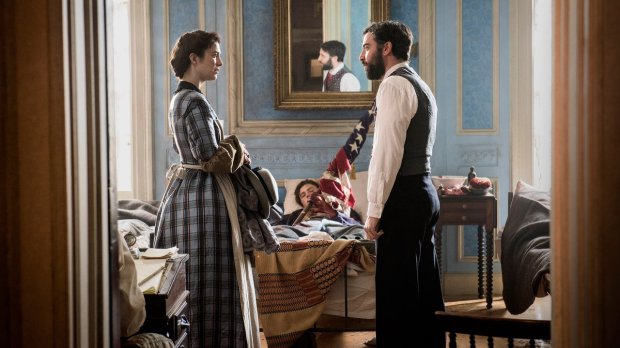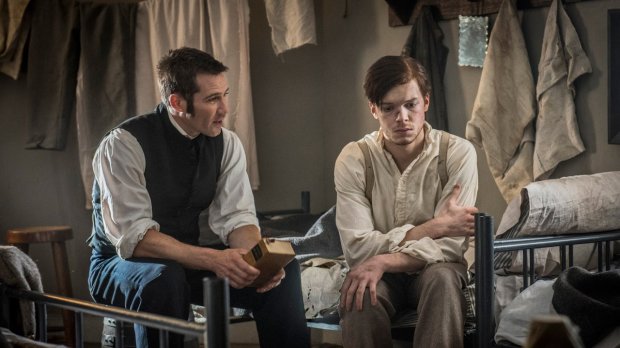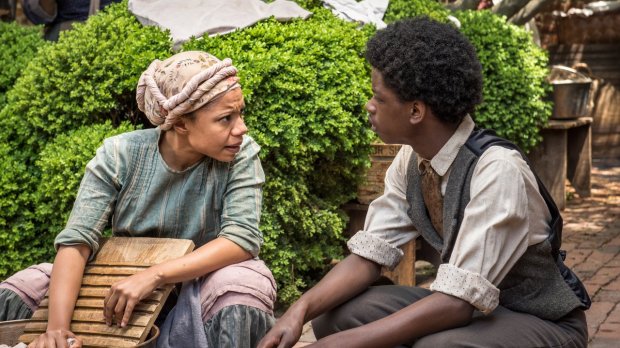As a historian of early America, I looked forward eagerly to the premiere of PBS’s Civil War drama Mercy Street. Now, four episodes in, I am looking forward eagerly to the final two episodes in the season. I thought I would share some of my thoughts on the show, as a historian and as a fan of PBS period dramas.

Mary Phinney (Mary Elizabeth Winstead) talks to Dr. Jedediah Foster (Josh Radnor) in Episode 1 of Mercy Street. (Source: http://www.pbs.org/mercy-street/extras/photos/)
Mercy Street takes place in Union-occupied Alexandria, Virginia in 1862. The action centers on Mansion House, a Union hospital and the former hotel of the Confederate-sympathizing Green family. New arrival Mary Phinney (Mary Elizabeth Winstead) courageously works to adjust to her new position as Head Nurse amidst jealousy and opposition. Doctor Jedediah Foster (Josh Radnor) tries to implement innovative medical techniques to save the soldiers under his care as he suffers a debilitating addiction. Aurelia Johnson (Shalita Grant), a former slave and laundress at Mansion House, longs for true freedom as she experiences with the unwanted attentions of the hospital steward. Emma Green (Hannah James), previously a somewhat spoiled southern belle, matures as she nurses Confederate soldiers at Mansion House, including her deeply troubled friend, Tom Fairfax (Cameron Monaghan). There are quite a few additional twists and turns in the plot, but I want to avoid spoilers.
Mercy Street is a period drama with very modern sensibilities and themes, most notably addiction and PTSD. I have to commend the writers of the show for dealing with these issues, which without question existed during the Civil War, but are often ignored. Both Josh Radnor as Dr. Foster and Cameron Monaghan as Tom Fairfax give outstanding performances as individuals struggling with these silent nemeses.

The hospital chaplain talks to troubled Confederate soldier Tom Fairfax (Cameron Monaghan) in Episode 2 of Mercy Street. (Source: http://www.pbs.org/mercy-street/extras/photos/)
Mercy Street‘s portrayal of Civil War medicine seems very realistic to me. Apparently, a doctor and historian of Civil War medicine taught the actors Civil War-era medical techniques, which they practiced extensively before filming. In one scene, Dr. Foster, Nurse Phinney, and Emma Green amputate a soldier’s leg. Such a scene is something of a mainstay in films on the Civil War, but, during this scene, I felt like I was seeing the situation for the first time, given the attention that the filmmakers and actors played to actual Civil War-era amputation techniques. The scene was also incredibly emotionally wrenching.

Aurelia Johnson (Shalita Grant) tries to convince an enslaved boy to run away from his mistress in Episode 3 of Mercy Street. (Source: http://www.pbs.org/mercy-street/extras/photos/)
The show also does an excellent job of portraying the complicated and uncertain status of African Americans in a formerly Confederate city occupied by the Union early in the war. After the war began, it took over a year for the policy of the Union army to be formally clarified in the Confiscation Act of 1862, which freed slaves belonging to Confederates in Union-occupied areas. Yet, the law was not always enforced, and, if they wanted freedom, enslaved African Americans often had to seize it for themselves, as depicted accurately in Mercy Street. In addition, even after they became free, former slaves still experienced discrimination and abuse, portrayed heartbreakingly through the experiences of Aurelia Johnson in the show.
As a historian and as a fan of period dramas, I would highly recommend Mercy Street. Each episode expertly evoked the historical situations that I have so often read about in scholarly works on the Civil War, while also communicating the human experiences of anguish and triumph that accompanied them.
One thought on “Musings on Mercy Street, Part One”
Comments are closed.